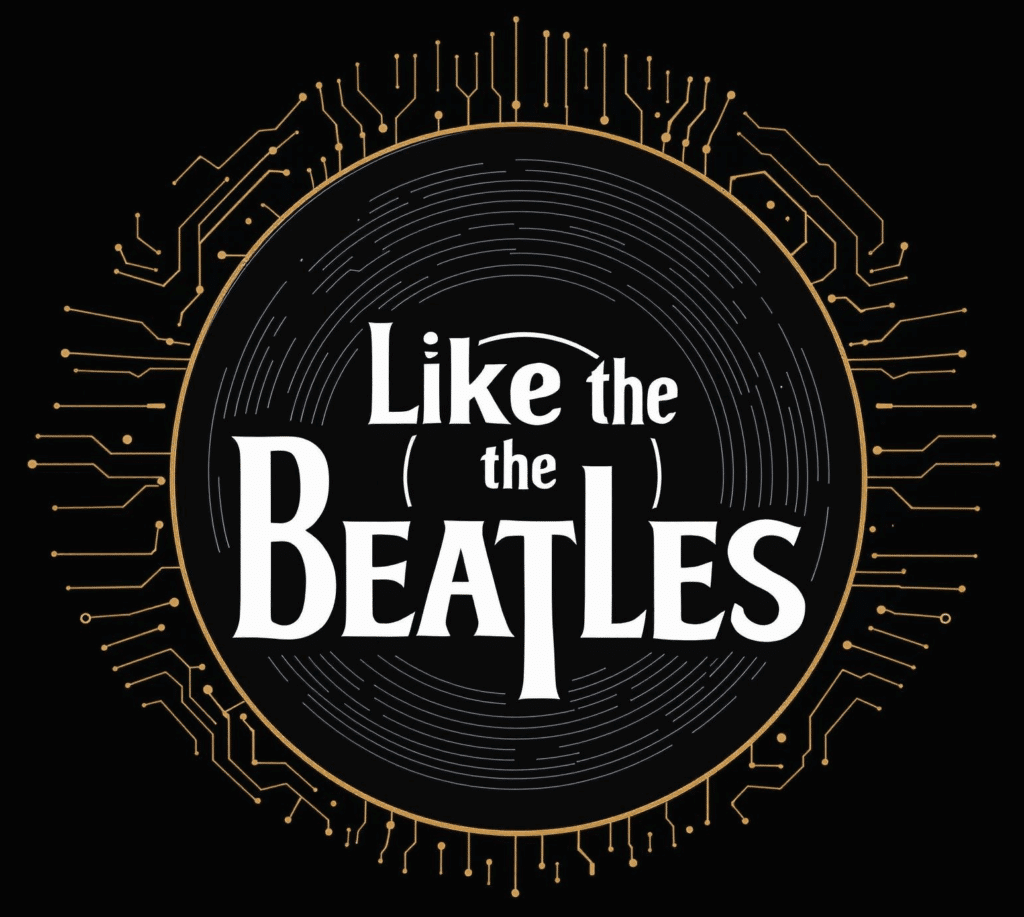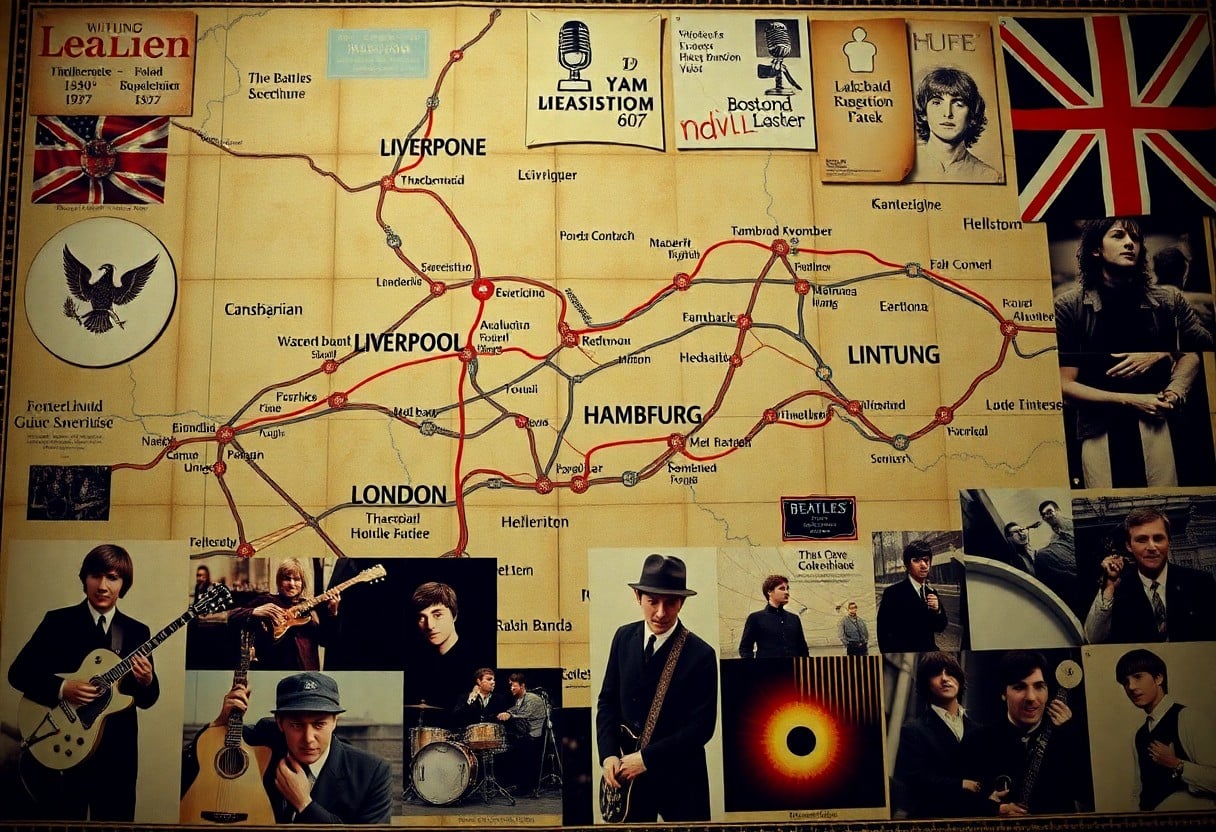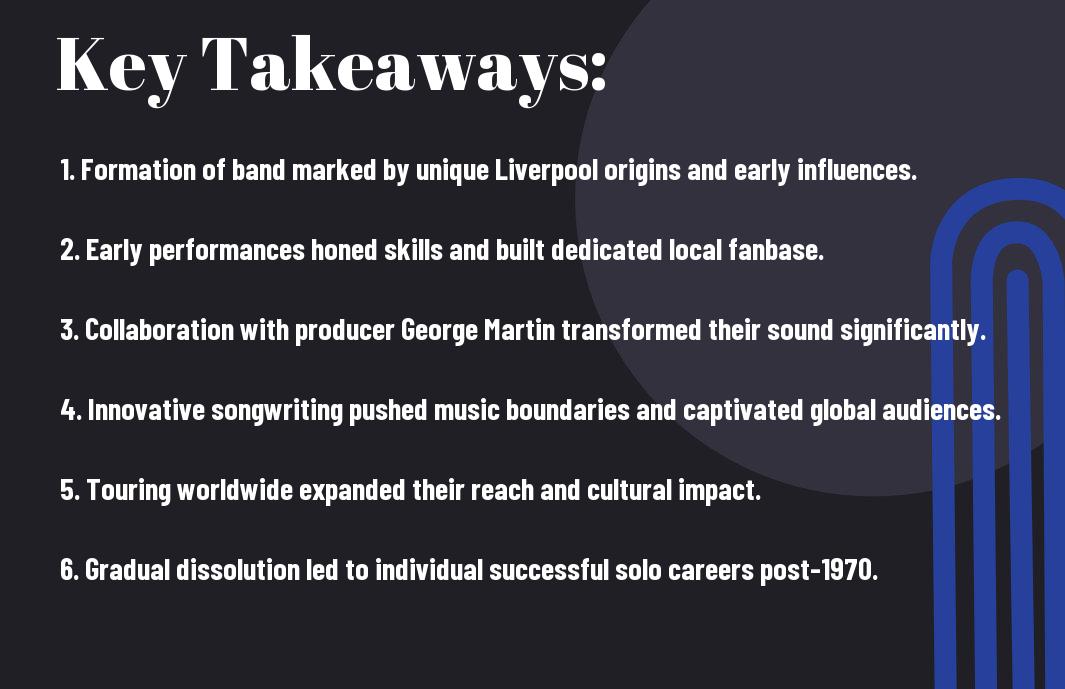There’s no denying the profound impact The Beatles had on music and culture, and in this post, I will guide you through 10 key steps that defined their incredible journey. From their early days in Liverpool to their groundbreaking albums, each phase was marked by transformative experiences and significant decisions. I’ll explore how these moments not only shaped their sound but also changed the landscape of popular music forever. Join me as we map out this legendary band’s path from start to finish.
The Early Years: Formation and Influences
For any Beatles fan, understanding the early years provides vital context to their transformative journey in music. This era highlights the formation of the group, key influences, and the experiences that shaped their unique sound, ultimately marking the beginning of a cultural phenomenon. From skiffle and rock n’ roll roots to the synergy between its members, the foundations laid during these years were crucial in paving their path to stardom.
The Quarrymen and the Beginnings
Formation of The Quarrymen in 1956 included John Lennon, who led the band, alongside his school friends. The group was initially a skiffle band, playing easy-to-learn American folk songs, embodying the youthful spirit of post-war Britain. As they ventured into various styles and gigs at local venues, it was evident that this small band was just on the brink of something extraordinary.
Key Influences and Early Inspiration
Early on, the Beatles drew inspiration from an array of musical genres and artists, shaping their sound that would later captivate the world.
Even during their formative years, the diverse musical landscape profoundly influenced the group. They were inspired by American rock and roll icons such as Elvis Presley and Chuck Berry, while also drawing from the sounds of skiffle and rhythm & blues. This eclectic mix not only encouraged their creativity but also solidified a unique sound that set them apart. Furthermore, the experiences of their teenage lives in Liverpool, marked by exploration and adventure, infused a sense of authenticity and relatability into their music, paving the way for their future success.
Rise to Fame: The Beatlemania Era
You can’t discuss the journey of The Beatles without highlighting the explosive phenomenon known as Beatlemania. This era saw the band transition from local sensations to global icons, captivating audiences around the world with their charisma and innovative sound. Their magnetic rise ignited a cultural shift that reshaped music and youth culture, making them not just a band, but a symbol of a generation.
Breakthrough with “Please Please Me”
Please note that the release of “Please Please Me” in 1963 was a game-changer for The Beatles. This infectious track, paired with the energy and charm of the band, propelled them from obscurity into the mainstream music scene. The song’s success laid the groundwork for their meteoric rise, setting the stage for what was to come.
The Impact of the Ed Sullivan Show
Fame arrived on a grand scale for The Beatles when they performed on “The Ed Sullivan Show” in February 1964. This landmark event drew an estimated 73 million viewers, solidifying their status as international superstars. The band’s energetic and engaging performance not only secured their place in American pop culture but also marked a significant shift in the music industry as they influenced countless artists. The Beatlemania that followed created a frenzied fan culture, uniting millions in a shared love for their music, and demonstrating the undeniable power of television in shaping public perception.
Rise to this historic moment catalyzed The Beatles’ fame, exposing them to a vast audience and paving the way for their enduring legacy. Their appearance on the show transformed not just their careers but also the landscape of music and entertainment, showcasing the herald of a new era in popular culture.
Musical Evolution: Exploring New Sounds
Not only did The Beatles’ sound evolve throughout their career, they continuously pushed the boundaries of music by embracing new styles and technologies. With every album, they rejected the conventional, consistently seeking to innovate. For more context, check out this Excerpt: The Beatles’ second single put the band on the map.
The Rubber Soul and Revolver Expansions
One of the most significant shifts in The Beatles’ sound occurred with the release of “Rubber Soul” and “Revolver.” These albums showcased their willingness to explore themes of introspection and experimentation with a diverse range of instruments, including the sitar and tape loops. As I listen, I hear the foundations of modern rock being laid down, paving the way for future generations.
Psychedelia: Sgt. Pepper’s Lonely Hearts Club Band
Above all, “Sgt. Pepper’s Lonely Hearts Club Band” epitomized The Beatles’ leap into psychedelia. This groundbreaking album embraced vivid imagery, unconventional song structures, and experimental sounds. It symbolized a cultural shift as their music reflected the spirit of the ’60s. By incorporating orchestral arrangements and cutting-edge studio techniques, The Beatles forever altered the landscape of popular music and challenged your perception of what an album could represent.
Hearts filled with creativity and audacity, The Beatles constructed “Sgt. Pepper’s” as a mosaic of rich textures and eclectic influences. Each track is a kaleidoscope of sound, inviting you to begin on a journey through mind-altering lyrics and extraordinary instrumentals. The blend of rock, folk, and Eastern sounds established a new paradigm for artists to express themselves. This evolution signified not just a musical revolution but also a profound shift in artistic consciousness, uniting a generation in its quest for self-exploration and freedom.
The Transition: From Touring to Studio Innovation
Despite their phenomenal success on the road, The Beatles made a pivotal choice to pivot from touring to studio innovation. This transition marked a significant shift in their creative process, allowing them to explore more experimental sounds and intricate arrangements without the constraints of live performances. The studio became their playground, where imagination ran wild and boundaries were pushed, ultimately reshaping the landscape of modern music.
The Decision to Stop Touring
Transitioning away from touring was not a decision taken lightly by The Beatles. By 1966, the constant demands of live performances had taken a toll on them, both physically and mentally. Each concert was filled with frenzied fans and overwhelming noise, stifling their ability to perform their evolving musical style. I can only imagine the weight of realizing that by stepping away from the stage, they would have a chance to redefine their artistry.
The Recording Revolution: Abbey Road
Below the sunlit arches of Abbey Road Studios, The Beatles began crafting some of their most iconic music. This period marked a departure from traditional recording techniques as they embraced innovative practices that transformed their sound.
Consequently, during their time at Abbey Road, the band experimented with technology and sound manipulation, leading to groundbreaking tracks like “Come Together” and “Here Comes the Sun.” They utilized multi-tracking and unique instrumentation, which added layers of complexity to their work. This evolution was not merely about music; it was a reflection of their journey and commitment to pushing the envelope. The result was a timeless album that resonated with generations, proving that leaving the stage had unleashed their full creative potential in the studio.
Personal Dynamics: Relationships and Conflicts
Once again, I find myself captivated by the intricate web of relationships and conflicts that defined The Beatles. The group’s dynamic was not just about music; it was a complex interplay of friendship, rivalry, and creativity. Each member brought unique perspectives, which often led to both inspiring collaborations and significant tensions. Understanding these personal dynamics is important for anyone looking to grasp the true essence of their journey.
The Bond of Brotherhood
After experiencing the highs and lows of fame, I realize that the bond of brotherhood among The Beatles was both unbreakable and fragile. Their shared experiences forged an intimate connection, yet celebrity life also placed immense pressure on their friendship. This unique camaraderie fueled their creativity, but the very closeness that brought them together also made it harder to navigate conflicts as they arose.
Tensions and Creative Differences
About the tensions and creative differences, I find it fascinating how these factors often shaped The Beatles’ music. Dynamics within the band fluctuated, revealing both passionate debates and intense disagreements. These creative clashes were not simply roadblocks; they often led to innovative breakthroughs and growth. While the friction could cause friction, it also inspired some of their most iconic songs. The push and pull of their differing artistic visions kept the collaboration vibrant, even amid challenges.
Dynamics among The Beatles were complex and multifaceted. Their disagreements often lay in differing musical visions, as each member sought to explore distinct creative paths. John and Paul frequently found themselves at odds, with John leaning towards experimental sounds while Paul favored more melodic structures. This push and pull sparked not only tension but also creative evolution, leading to groundbreaking compositions. However, the pressure of conflicting ideas eventually contributed to the group’s disbandment, showcasing how even the strongest friendships can fray under the weight of ambition and artistic differences.
The Final Chapters: Solo Careers and Legacy
Now, as The Beatles transitioned into their solo careers, each member launched on a unique journey that would allow them to further explore their musical identities. While John Lennon embraced introspective and politically charged themes, Paul McCartney pursued a more pop-oriented sound with Wings. George Harrison explored into spiritual and world music, while Ringo Starr brought forth a mix of rock and easy listening. Despite their departures from the band, their individual journeys contributed significantly to their enduring legacy.
The Breakup and Individual Paths
Above all, the breakup of The Beatles in 1970 marked a significant turning point, leading each member to carve out their own distinctive musical paths. While some fans viewed this as the end of an era, it was instead the beginning of a new chapter for each artist. Lennon took an activist role, McCartney found commercial success with his cheerful melodies, Harrison ventured into experimental sounds, and Starr remained a beloved figure in rock, showcasing how each one’s individuality thrived post-Beatles.
Lasting Impact on Music and Culture
Legacy wise, The Beatles’ influence on music and culture has been profound and far-reaching. Their innovative studio techniques and willingness to push artistic boundaries have set a standard for musicians across genres. With unforgettable hits and groundbreaking albums, they transformed popular music and inspired countless artists. The Beatles’ message of love, peace, and experimentation resonated not just in the ’60s but continues to inspire today’s musicians and fans alike. You can see their legacy reflected in everything from contemporary pop to hip-hop, showing how their artistry has shaped modern culture.
Paths of The Beatles continue to influence global music culture, intertwining with social movements and artistic expressions. By challenging the status quo and embracing new sounds, they became symbols of change during a time of upheaval. The blend of their individual styles has allowed future generations to draw upon their work, ensuring their place in the annals of music history. From festivals to film, their impact extends beyond just sound; it has become a cultural touchstone that endures, illustrating the power of their art and vision.
To wrap up
So, as we’ve explored, mapping the journey of The Beatles through these ten key steps reveals the transformative impact they had on music and culture. From their early days in Liverpool to global superstardom and innovative experimentation, each phase shaped not just their careers but the landscape of popular music. I think understanding this timeline gives you a deeper appreciation for their artistry and the factors that drove their evolution. This legacy continues to influence artists today, making their story as relevant now as it was then.












